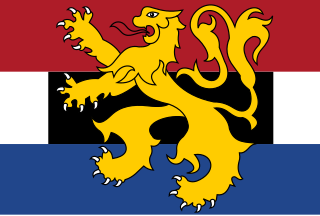 W
WThe flag of Benelux is an unofficial flag commissioned by the Committee for Belgian-Dutch-Luxembourgian Cooperation in 1951. It is an amalgam of the flags of the member states: Belgium, the Netherlands, and Luxembourg. The red stripe is from the Flag of Luxembourg, the blue stripe is from the Flag of the Netherlands, and the black stripe and yellow lion rampant are taken from the Coat of arms of Belgium. The lion also historically represents the Benelux - or in other words, the Low Countries - area as a whole, since each constituent nation possesses a coat of arms featuring a lion rampant facing left, which during the 17th century already symbolised the Low Lands as a whole or in part.
 W
WThe Black Bauhinia flag is a variant of the flag of Hong Kong with a black background and a modified flower. The flag gained popularity during the 2019–2020 Hong Kong protests and is often displayed by pro-democracy protesters.
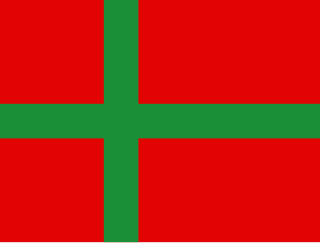 W
WThe flag of Bornholm emerged in the mid-1970s after a design by local painter Bent Kaas, and is used to some extent. Mainly as a souvenir bought by tourists, military units while on exercise in Denmark and on foreign missions, and by mainly German sailors visiting Bornholm. It is the Danish flag with a green Nordic cross in the centre. The green is said to symbolize the natural greenery of the island. The other variant resembles Norway's Flag, except with a green inner cross.
 W
WThe Calcutta flag was one of the first unofficial flags of India. It was designed by Sachindra Prasad Bose and Hemchandra Kanungo and unfurled on 7 August 1906 at Parsi Bagan Square, Calcutta.
 W
WThe Canadian Duality Flag is an unofficial flag that was originally circulated to demonstrate the unity of Canada during the lead-up to the 1995 Quebec referendum, at rallies for the "no" side. The Duality Flag design was chosen to represent explicitly the Francophone and Anglophone populations on the national flag by adding blue stripes to the red sections, roughly in proportion to the number of Canadians who are primarily French-speaking. The blue was chosen as it is the main colour that is used on the flag of Quebec.
 W
WThe unofficial flag of the Chatham Islands is a blue field with a map of the island in the centre, the Te Whanga Lagoon depicted in white. Behind this device map is a depiction of the rising sun, an allusion to its local name Rekohu, meaning 'rising sun'.
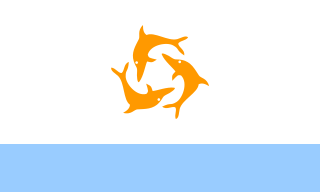 W
WThe Dolphin Flag of Anguilla was adopted on September 29, 1967, after the colony unilaterally declared independence from the United Kingdom as the Republic of Anguilla. It depicted three orange dolphins in a circle on a white background with a turquoise stripe at the bottom. It was used until March 19, 1969, when British rule was restored.
 W
WThe Doug flag, also referred to as the Cascadian flag or the Cascadia Doug flag and nicknamed "Old Doug" or simply "the Doug", is one of the primary symbols and an unofficial flag of the Cascadia bioregion, which roughly encompasses the U.S. states of Oregon, Idaho, and Washington, the Canadian province of British Columbia, and other parts of North America's Pacific Northwest. It was designed by Portland, Oregon native Alexander Baretich in the academic year of 1994–1995. It is named after the Douglas fir, featured on the flag.
 W
WThe Estelada is an unofficial flag typically flown by Catalan independence supporters to express their support for either an independent Catalonia or independent Països Catalans. The use of this flag as a protest symbol within Catalan nationalism has become more notable since the 1970s Spanish transition to democracy. The design of the Estelada comprises the red-and-yellow bars of the Senyera, with the addition of a five-pointed star in a triangle at the hoist. It was not adopted as the national flag of the proclaimed Catalan Republic (2017), the legitimacy of which was disputed. Instead the senyera was the flag that was used.
 W
WThe flag of Labrador, while unofficial, is used to represent Labrador, the continental region with adjacent islands of the Canadian province of Newfoundland and Labrador as distinct from the Newfoundland region of the province. It was created by a small group led by Michael S. Martin, who was then the representative for Labrador South in the provincial legislature. The flag has been influential in Labrador; its colours are mirrored in the flag of Nunatsiavut, and its black (bog) spruce twig was adopted for use on the Franco-Terreneuvien flag. The black spruce, a member of the pine family, is the most numerous tree in Labrador and in the Province of Newfoundland and Labrador. The black spruce is the official tree of the Province of Newfoundland and Labrador and thus serves as a reminder that Labrador is part of that larger entity.
 W
WThe Flag of Lord Howe Island is the unofficial flag of the island, an unincorporated area of New South Wales administered by the Lord Howe Island Board. The unofficial flag of Lord Howe Island, which was designed by Sydney-based vexillologist John Vaughan, was first flown in November 1998. The yellow centre of the flag evokes the island's topography and depicts a Kentia palm, while the surrounding area of flag utilizes the pre-1801 Union Jack, excluding the red of St George's Cross and Saint Patrick's Saltire.
 W
WThe unofficial flag of the Marquesas Islands was first raised on December 14, 1980, upon the opening of the airport on Nuku Hiva, and has been regularly used since 1994. A simplified version, without the tiki design, is sometimes flown.
 W
WA flag of Mars is a flag or flag design that represents the planet Mars or that represents a fictional Martian government.
 W
WNavassa Island is a small uninhabited island in the Caribbean Sea. Located northeast of Jamaica, south of Cuba, and 40 nautical miles west of Jérémie on the Tiburon Peninsula of Haiti, it is subject to an ongoing territorial dispute between Haiti and the United States, which administers the island through the U.S. Fish and Wildlife Service.
 W
WThe Newfoundland Tricolour, or the Pink, White and Green, is an unofficial flag seen in the Canadian province of Newfoundland and Labrador, and is mistakenly believed to have been an official Flag of Newfoundland and Labrador, or more commonly, of the island of Newfoundland specifically.
 W
WThe Proposed Flag of North West England is an unofficial flag design which was created by graphic designer Peter Saville in 2004 following announcements by the British Government to put forward plans for the establishment of elected regional assemblies in England. The flag was supported by a pro-regionalist group, The Necessary Group which founded by Tony Wilson consisted of people who were in support of devolution in the North West.
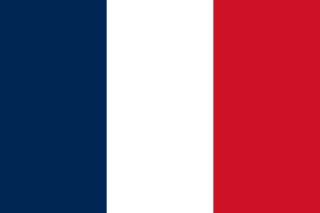 W
WThe flag of Saint Pierre and Miquelon is officially the flag of France, as Saint Pierre and Miquelon is a self-governing overseas collectivity of France.
 W
WA silver fern flag is any flag design that incorporates a silver fern, and is usually a white silver fern on a black background. The silver fern motif is associated with New Zealand, and a silver fern flag may be used as an unofficial flag of New Zealand, to which it is endemic. The silver fern itself is a quasi-national emblem, being used for various official symbols, including the coat of arms of New Zealand and the New Zealand one dollar coin. A number of New Zealand sports teams, such as the cricket team, the Silver Ferns and the All Blacks, use similar silver fern flags as part of their official merchandise. The All Whites association football team use a white background and a black version of the fern.
 W
WThe flag of the Swedish-speaking Finns is an unofficial red flag with a yellow cross used in the Swedish-speaking parts of Finland to represent the Finland-Swedes. It may be flown in addition to the Finnish blue and white flag. This flag is unfamiliar to many in Finland but there have been attempts to introduce it again to a broader audience as what is known as "household pennants" demonstrating one's identity as Swedish-speaking, are more common and can be seen on many flagpoles in areas where there live many Swedish-speaking Finns, especially in countryside.
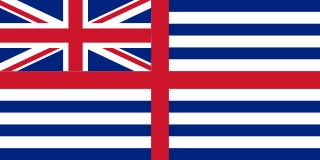 W
WThe Van Diemen's Land Ensign is an unofficial merchant flag, which was used in the colony prior to the adoption of the current Tasmanian Flag in 1875. The earliest known reference to the Van Diemen's Land Ensign is from an 1850s flag chart by Captain John Nicholson, Harbour Master of Sydney. The flag is similar in design to the New South Wales Merchant Flag, which is believed to also be the historical origin of the Murray River Flag.